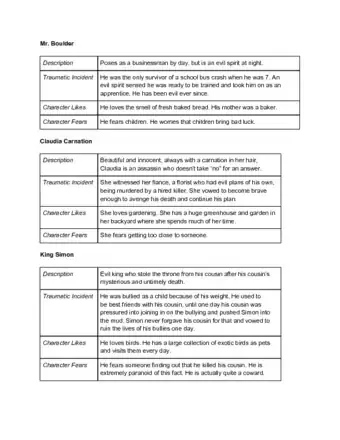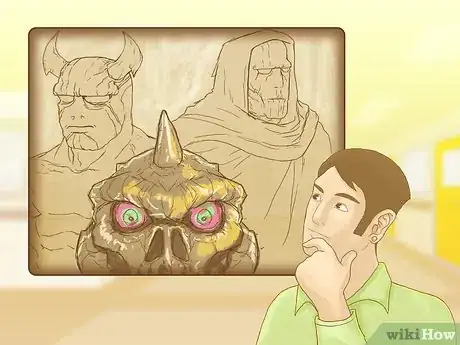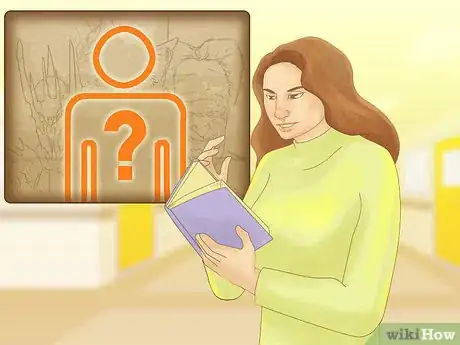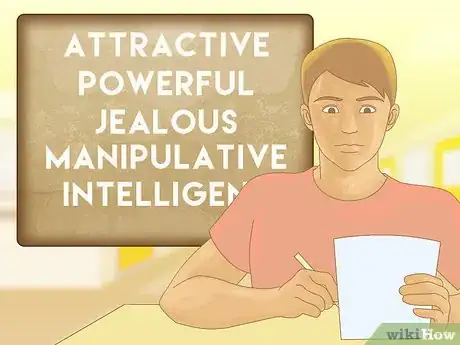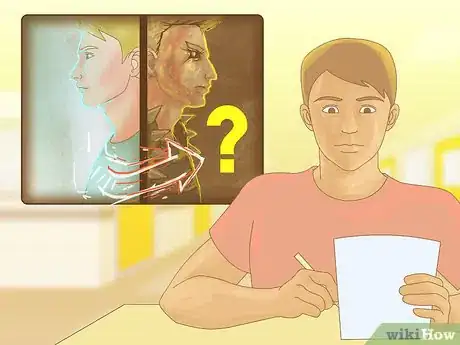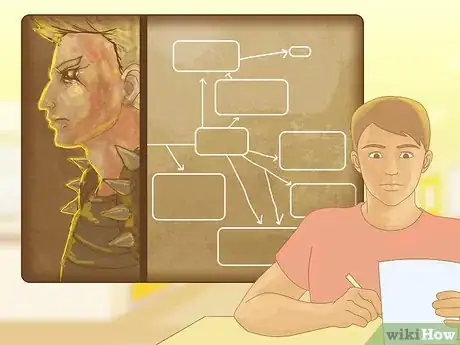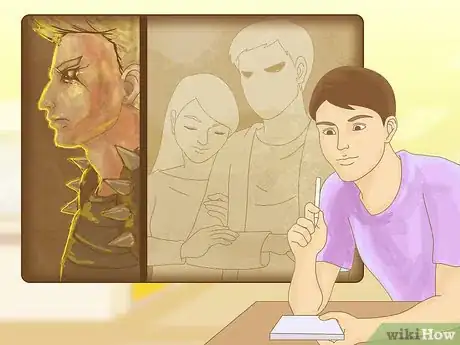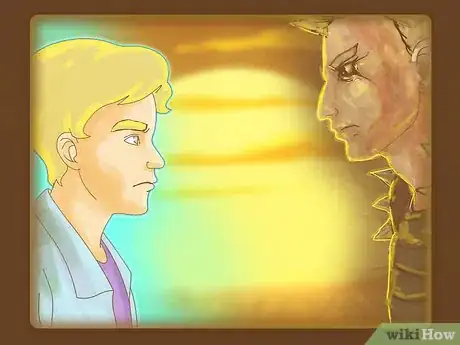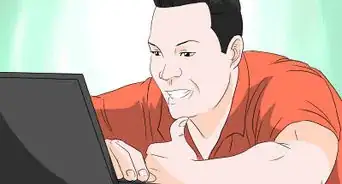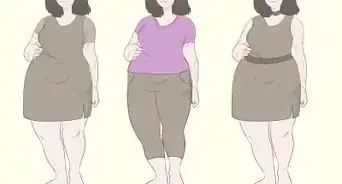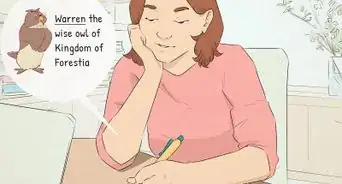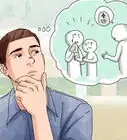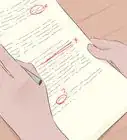This article was co-authored by Lucy V. Hay. Lucy V. Hay is an author, script editor and blogger who helps other writers through writing workshops, courses, and her blog Bang2Write. Lucy is the producer of two British thrillers and her debut crime novel, The Other Twin, is currently being adapted for the screen by Free@Last TV, makers of the Emmy-nominated Agatha Raisin.
wikiHow marks an article as reader-approved once it receives enough positive feedback. In this case, 100% of readers who voted found the article helpful, earning it our reader-approved status.
This article has been viewed 121,579 times.
A good villain in a story can wreak havoc on other characters and help to generate conflict. Creating a perfect villain can raise your story to the next level. To create a perfect villain, you should first understand the role of a villain, build a backstory for the villain and then put the villain into action in your story.
Steps
Sample Character Description
Recognizing the Role of a Villain
-
1Understand the difference between a villain and a hero. In a traditional story, the hero is the good person, the one a reader or viewer will root for. The villain is often portrayed as the bad person, representing evil and darkness in the story. The struggle between the hero and the villain sets up the major conflict in traditional stories, with the hope that the hero wins and the villain fails.[1]
- Keep in mind villains are often more terrifying and memorable to readers if they are multi-dimensional. Often, a villain who is as developed and detailed as the hero in a story will keep the reader engaged in the conflict and build tension. Taking the time to craft a well developed villain will only help your story become stronger and more memorable.
- Avoid using an abstract concept, such as a disease, a war, or a corporation, as a villain. Abstract villains are often too vague and general to elicit much emotion from your audience. If you do want to use an abstract concept, relate it to a particular person or being who will act as the villain in your story.[2]
-
2Read examples of villains. To get a better sense of how you can create a perfect villain, you should read examples of villains who are popular and memorable. Consider your favorite fictional antagonists. For example:[3]
- Professor Moriarty from Sherlock Holmes by Sir Arthur Doyle.
- Satan from Paradise Lost by John Milton.
- Count Dracula from Dracula by Bram Stoker.
- Sauron from The Lord of the Rings by J.R.R. Tolkien.
- Voldemort from the Harry Potter series by J.K. Rowling.
- Darth Vader (Anakin Skywalker) from the Star Wars series.
Advertisement -
3Analyze the examples. Once you have read several examples of villains in literature, you should consider how the author crafts their villain. You should also think about how certain villains are similar to one another and how they differ.
- You may ask yourself, How does the author characterize the villain? Does the author use physical and emotional characteristics to describe the villain? How does the villain interact with the hero of the story? What is the role of the villain in the story?
- For example, you may think about how Tolkien’s Sauron is considered representative of all-encompassing evil in The Lord of the Rings. Sauron is characterized by his power over the all-seeing eye, which sees everything in Middle Earth like the ultimate Big Brother.
- In contrast, Doyle’s Dr. Moriarty is a criminal mastermind who tries to outsmart using intelligence. Tolkien’s villain uses magic and Doyle’s villain uses intelligence, but both villains push their respective stories forward into conflict.
Building Backstory for the Villain
-
1Use an existing person as a model for the villain. To help you get inspiration for your villain, you may a person who already exists that you find terrifying. This could be your older sibling, a family friend, or a celebrity. Using an existing person as a model can help make it easier to then add or subtract elements to create your own fictional version of the person.[4]
- For example, maybe you create a villain based on a famous dictator, like Mao, or a villain based on your scary Aunt Edna. You may exaggerate some of the real life details of the person to make them appear more threatening or intimidating. Maybe you give Aunt Edna a physical trait that is scary, such as a glass eye or a facial scar. Or, maybe you exaggerate her personality, making her meaner and more aggressive.
- You may also look into historical figures who have been known as villains, such as serial killers or political figures. You could then add details to the historical figure to make them appear more villainous.
-
2List the villain’s five key character traits. You can get a better sense of the villain by defining them by their key character traits. These could be simple one word descriptors that help you paint a better picture of the villain and their goals once you sit down to write the story.[5]
- Try to think of character traits that are more than just “evil” or “crazy”. Look for character traits that will define your particular villain and make them more than just a one note character. For example, you may write down, “attractive”, “powerful”, “jealous”, “intelligent”, “manipulative”, "charismatic", "observant", or “quiet”.
-
3Determine how and when the villain turned to the dark side. Many of the more popular and successful villains in literature have engaging backstories, where they have a history of bad deeds due to a pivotal event in their lives. Determining what event or moment made the villain turn dark can help to create a more fleshed out character. It also allows you to avoid creating a one dimensional villain who only appears evil for evil’s sake.[6]
- For example, you may have a villain who witnessed trauma at a young age, such as violence, abuse, or abandonment. Or, you may have a villain who stumbled into a bad situation and made poor moral judgement. This may then have led the villain down a dark path.
-
4Outline the dark things done by the villain in the past. Add to the villain’s backstory by outlining their bad deeds. This may be a progression of smaller bad deeds to bigger bad deeds, or one or two awful things done within a certain period of time. Try to be detailed about these deeds, as this will help you build the villain into a living, breathing character who nevertheless makes choices and decisions just like everyone else.[7]
- For example, you may list bad deeds done by the villain, such as hurting specific characters or killing someone. You may also note how these deeds were done. Maybe the villain got his henchmen to kill someone or personally hurt specific characters in vindictive and sadistic ways. These dark things could then trigger the hero to go after the villain.
-
5Give your villain humanizing traits. Good villains will cause readers to question their moral judgements as they may end up sympathizing with the villain, despite the bad things they have done. A villain who is both sympathetic and evil is way more interesting than a villain who is just pure evil, as readers will be quick to dismiss them and unable to relate to them. Giving your villain humanizing traits will prevent them from becoming a one-dimensional character.[8]
- For example, you may have a villain who cares for their children and is a good parent, despite their secret life as a serial killer. Or maybe have a villain who spares an innocent bystander, despite their evil master plan to take over the world.
- The villain Satan from Milton's Paradise Lost is portrayed as a fallen angel from heaven who is an outsider and an outcast. These qualities are humanizing because most of us can relate to the feeling of being isolated or rejected in our own lives. This makes Milton's portrayal of Satan more sympathetic and nuanced.
- Adding details that make the villain human will also allow your story to feel more developed and well-rounded. A good rule of thumb is to make sure your villain is as detailed and defined as your hero. This way, the showdown between the two of them at the climax of the story will feel that much more exciting and engaging.
-
6Decide if your villain will have special powers or abilities. This may depend on if you are creating a villain for a genre story, such as a fantasy story, or if your story is based more in reality or the thriller genre. Your villain may have special powers or abilities that allow them to get a leg up on the hero and do incredible feats of evil. Giving your villain a specific power or ability will deepen their character and raise the stakes of the story.[9]
- For example, maybe your villain is a genius mad scientist who uses these scientific abilities to create an evil monster. Or, maybe your villain can access dark magic, which then allows them to wreak havoc on a peaceful land.
- You may want to consider giving your villain powers or abilities that run counter to your hero’s powers or abilities. For example, maybe your hero is brilliant at a specific form of good magic, which runs counter to the villain’s skills in dark magic.
Putting the Villain into Action
-
1Determine the conflict between the villain and the hero of your story. Once you have given your villain a convincing backstory, you should think about the nature of the conflict between your villain and your hero. This will allow you to add to the villain’s character and get a good sense of the villain’s motivation as a character. Outlining their conflict will also help you structure the rest of the story, starting from the beginning of the conflict and building up to the showdown between the villain and the hero.[10]
- For example, the villain may desire powers that only the hero can access. This may then lead to the villain seeking out the hero and plotting to control the hero for her use. Or, maybe your villain can only achieve her goal by taking something from the hero. They may then pursue the hero and hurt the hero, leading the hero to retaliate and fight back.
-
2Give the villain a unique voice. One way to characterize the villain in a scene so they stand out is to give them a distinctive voice. Think about how the villain might speak to others in a scene or to the hero. Maybe the villain has a unique perspective on a situation that comes through in the way they speak.[11]
- Ask yourself, Does the villain have an accent when they speak? Do they use different wording or phrasing that indicates their evil nature? Many villains will speak with menace and use words to manipulate weaker characters. Maybe your villain is skilled at wordplay and uses words to confuse or trick other characters.
-
3Create a master plan for the villain. To give your villain purpose and meaning in your story, you should map out their master plan. Doing this will also allow you to structure your story around the villain’s master plan or factor in the master plan when thinking about how the hero will move through your story. Most villains have elaborate plans with an ultimate goal or endgame. Defining this will also ensure your villain appears determined and motivated in every scene of your story, as they have a clear purpose or goal.[12]
- For example, your villain may have a master plan to use science to create a monster that will wreak havoc on the city and allow them to take vengeance on those who have wronged them in the past. This master plan may then have several parts that you will need to show your reader so they get a sense of the villain’s plan.
- Your villain may also work more in the shadows or pull strings behind the scenes, moving one step ahead of your hero. You may integrate their master plan into the larger story by having the hero discover clues of the plan, leading to the ultimate showdown between the hero and the villain.
-
4Build up to a showdown between the hero and the villain. A perfect villain requires the ultimate showdown between good and evil. Your story should have a plot outline that builds up to a face off where the villain and the hero battle in some way. This should be the high point of conflict and tension in the story, where the villain finally unveils their true intentions to the hero.[13]
- Your villain and your hero may battle through a game of wits or a battle of magic. Or, your villain may set a trap that your hero must survive or a test that your hero must solve. Make sure the showdown is full of obstacles and difficulties created by the villain so the stakes are high for both the villain and the hero in your story.
Community Q&A
-
QuestionCould the villain win in the end?
 Community AnswerYes. The story where the good guys die and the bad guys win always gets interest, so you could totally make the villain win. Just make sure it fits the mood of your story. (If you're writing a fairy tale, the "dragon" should probably be defeated at the end.)
Community AnswerYes. The story where the good guys die and the bad guys win always gets interest, so you could totally make the villain win. Just make sure it fits the mood of your story. (If you're writing a fairy tale, the "dragon" should probably be defeated at the end.) -
QuestionMy story has 9 villains who are forced to help each other. How do I make there unlikely joining believable when they're all very different?
 Community AnswerYou'll need to find a personal motivation for each to unite toward the common cause. As long as each villain's motivation is consistent with his or her character and personality, it will be believable. Introducing conflict among the villains on the team may make it even more believable.
Community AnswerYou'll need to find a personal motivation for each to unite toward the common cause. As long as each villain's motivation is consistent with his or her character and personality, it will be believable. Introducing conflict among the villains on the team may make it even more believable. -
QuestionCan the villain be the protagonist in a story?
 Community AnswerHe/she could be. I don't know if I would call a villain the protagonist, but he/she could be the main character.
Community AnswerHe/she could be. I don't know if I would call a villain the protagonist, but he/she could be the main character.
References
- ↑ http://www.writingforward.com/storytelling/create-a-villain
- ↑ http://www.writersdigest.com/online-editor/6-ways-to-write-better-bad-guys
- ↑ http://www.csmonitor.com/Books/2012/0711/10-greatest-villains-in-all-of-literature/Sauron-from-J.-R.-Tolkien-s-Lord-of-the-Rings
- ↑ http://www.writingforward.com/storytelling/create-a-villain
- ↑ http://www.scriptmag.com/features/ask-the-expert-how-to-create-a-great-villain
- ↑ http://www.writing-world.com/fiction/villains.shtml
- ↑ http://www.nownovel.com/blog/how-to-create-a-great-villain/
- ↑ http://www.writersdigest.com/online-editor/6-ways-to-write-better-bad-guys
- ↑ http://www.nownovel.com/blog/how-to-create-a-great-villain/
About This Article
When you’re writing a story, you’ll want to create the perfect villain to pit against your hero. Give your villain distinct personality traits aside from just being evil, such as intelligence, charisma, and being manipulative. Think about what made them evil in the first place, like abuse or a traumatic event in their past, since most villains weren’t born evil. You also want to make them human with their own hopes and fears so your readers will be able to understand them better. Decide what your villain wants, which will create conflict with your hero and set your story in motion. For example, in Batman, the Joker generally wants to create chaos while Batman wants to keep the peace. For more tips from our Creative Writing co-author, including how to get inspiration from your own life for your villain, read on!
